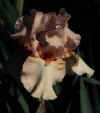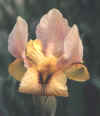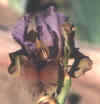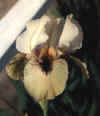Quarterbreds – the Historical Perspective
|
The road to modern quarterbreds has been a long one, with many detours and dead ends because they are not the product of traditional line-breeding. Instead, it's a process of finding a type of cross that works and making more crosses of the same type. Think of it as line-breeding information, rather than plants.
From the beginning, arilbred hybridizers have sought to put flowers with the beauty of the onco species on TB-like plants. In the late 1800s
and early 1900s this meant crossing diploid oncos with diploid TBs to get diploid
halfbreds, which were quite unlike our modern halfbreds. Back then, all arilbred hybridizing involved what we would now term wide crosses – with few takes, few seedlings, and limited fertility.
|
| |
Quarterbreds from the Triploid Route
|
A significant step toward modern quarterbreds was taken after the
tetraploid conversion of the TBs, when the diploid oncobreds were crossed with tetraploid
TBs. Genetically speaking, most of their offspring were not like modern
quarterbreds. From what we know of chromosome conjugation today, we realize that this type of cross normally produces two types of seedlings (triploid oncobreds and triploid
TBs), but once in a while an unreduced gamete from the diploid parent would result in an unbalanced tetraploid
oncobred. Because hybridizers were selecting for aril characteristics, we can assume that their selections were made from the
oncobreds. These fell out of favor when the newer types of quarterbreds came on the scene, so few are available today.
Many, like the seedling shown here, exhibit few aril traits themselves but
have enough fertility to produce offspring that do.
|

Lovely Blanche X Eunice |
|
|
Quarterbreds from Halfbreds
|
Once fully fertile amphidiploids were available, it became possible to produce quarterbreds in some quantity by crossing the halfbreds with tetraploid
TBs. The first significant group, quite understandably, came from Ib-Mac – because it was the first amphidiploid to be identified – but there were also others like Zwanenburg and Lady Lilford. When Capitola came on the scene, it proved to be so reliable that its many registered offspring
dominated the arilbred world of the early 1950s. Opals for Ethel,
one of the later introductions of this type, shows the characteristic
width that clearly set them apart from the TBs of that era. This is the
route by which most modern quarterbreds have been produced.
|

Opals for Ethel |
|
|
Quarterbreds from Near-Arils
|
More recently, chromosome-set quarterbreds have been produced by crossing near-arils with
TBs. The arilbred parent may be either a triploid or an unbalanced
tetraploid. The TB is usually the pod parent because of its later bloom season, and the offspring can be either fully fertile halfbreds or chromosome-set quarterbreds depending on chromosome conjugation. I'm not suggesting that this is easy. The challenge is in finding a near-aril with enough fertility to be of use, but both Tribe of Judah and Whirlwind Romance have given me some striking offspring when crossed onto
TBs. Raring to Go has the characteristically wide onco beard not
often seen on halfbreds today, much less on quarterbreds.
|

Raring to Go |
|
|
Using Quarterbreds to Produce more Quarterbreds
|
Another way to obtain arilbreds that qualify as "quarterbreds" by ASI standards is by crossing conventional quarterbreds back to
halfbreds. Under the quantum system, the resulting seedlings would have been termed "3/8-breds". In reality, the offspring tend to be like one of the parents, rather than an intermediate type. Some are infertile quarterbreds and some are fully functional
halfbreds, but there's no way to know which type a given seedling is without testing it.
It does seem to improve the odds if breeding stock is selected from
quarterbreds that themselves exhibit unusually strong aril traits, like Pixilated.
|

Pixilated |
This is also a difficult cross to make because of the relative infertility of the conventional
quarterbreds. There are exceptions, of course. Although far from fully fertile, the classic Lady Mohr has demonstrated enough compatibility with both TBs and halfbreds to have produced a number of registered offspring. The same holds true for Genetic Burst, except it has been used very little with TBs because of the change in rules. My own Joint Venture
isn't as fertile as the average halfbred, but it is much more fertile than any other quarterbred I've tried.
|

Joint Venture |
Most Joint Venture offspring show a considerably greater number of aril traits than do the traditional quarterbreds and some are almost indistinguishable from halfbreds in appearance. Test crosses divide them into two types: fertile halfbreds and relatively infertile
quarterbreds. Selection is thus more complicated than usual – first for
aril traits in the flower and for gardenability, then for determination of
type and evaluation against the standards for the type. Joint Venture is producing some delectable
things when crossed with halfbreds – it would be interesting to see what
it could do if partenered with TBs.
|

Don't Be Shy |
| All of which serves as a clear indication that we should test more quarterbreds instead of simply assuming that they aren't fertile. |